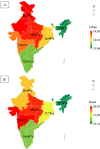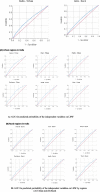Regional with urban-rural variation in low birth weight and its determinants of Indian children: findings from National Family Health Survey 5 data
- PMID: 37641012
- PMCID: PMC10464394
- DOI: 10.1186/s12884-023-05934-6
Regional with urban-rural variation in low birth weight and its determinants of Indian children: findings from National Family Health Survey 5 data
Abstract
Background: Low birth weight is a key indicator for child health, especially a concern in low-middle-income countries. However, health and medically-related reforms are being actively implemented in some middle-income countries like India. Identifying low birth weight (LBW) babies with their determinants across the whole country is essential to formulate regional and area-specific interventions. The objective of this study was to find out the burden and determinants of LBW on the regional and residential (rural-urban) divisions of India.
Methods: The present study was based on the NFHS-5 dataset (2019-21), a nationally representative survey in India. A total of 209,223 births were included in this study. A newborn weighing less than 2500 g was considered as LBW. According to the objectives, we used frequency distribution, chi-square test and binary logistic regression analysis for analysing the data.
Results: About 18.24% of the babies were LBW in India, significantly higher in rural areas than in urban areas (18.58% vs 17.36%). Regionally prevalence was more frequent in western (20.63%) and central (20.16%) rural areas. Regarding maternal concerns, in the eastern and southern regions of India, mothers aged 25-34 were less likely to have LBW children than mothers aged 35-49 years. It was found that the risk of LBW was more likely among the children born out of unintended pregnancies in almost all regions except for eastern part. In rural India, women who delivered children at home were more likely to have LBW children in India (AOR = 1.19, CI: 1.12-1.28, p < 0.001) and its central, northern, and southern regions than those who gave birth in institutions. The study indicates that LBW coexists with lower maternal education levels and poor household wealth index across all regions. About 58% and 57% of cumulative effects of independent variables on LBW can be distinguished in urban and rural India, respectively.
Conclusions: Targeted-specific strategies need to be undertaken as per region and geographical variations. Then only India should be able to decline LBW as proposed by National Health Policy.
Keywords: Birth weight; Public health; SDG; Under-five children; Wealth index.
© 2023. BioMed Central Ltd., part of Springer Nature.
Conflict of interest statement
The authors declare no competing interests.
Figures



Similar articles
-
Maternal determinants of low birth weight among Indian children: Evidence from the National Family Health Survey-4, 2015-16.PLoS One. 2020 Dec 31;15(12):e0244562. doi: 10.1371/journal.pone.0244562. eCollection 2020. PLoS One. 2020. PMID: 33382769 Free PMC article.
-
The association between birthweight, sociodemographic variables and maternal anthropometry in an urban sample from Dhaka, Bangladesh.Ann Hum Biol. 1997 Sep-Oct;24(5):387-401. doi: 10.1080/03014469700005152. Ann Hum Biol. 1997. PMID: 9300116
-
Geographical variation, socioeconomic inequalities of low birth weight, and its relationship with maternal dietary diversity: Insights from the maternal infant and young child nutrition programme in Bangladesh.J Glob Health. 2024 Oct 11;14:04209. doi: 10.7189/jogh.14.04209. J Glob Health. 2024. PMID: 39391893 Free PMC article.
-
Nutritional interventions for preventing stunting in children (birth to 59 months) living in urban slums in low- and middle-income countries (LMIC).Cochrane Database Syst Rev. 2019 Jun 17;6(6):CD011695. doi: 10.1002/14651858.CD011695.pub2. Cochrane Database Syst Rev. 2019. PMID: 31204795 Free PMC article.
-
Maternal malnutrition and anaemia in India: dysregulations leading to the 'thin-fat' phenotype in newborns.J Nutr Sci. 2021 Oct 11;10:e91. doi: 10.1017/jns.2021.83. eCollection 2021. J Nutr Sci. 2021. PMID: 34733503 Free PMC article. Review.
Cited by
-
Association Between Lung Function of Children and Their Socioeconomic Conditions: A Systematic Review.Int J Gen Med. 2024 May 18;17:2265-2278. doi: 10.2147/IJGM.S456643. eCollection 2024. Int J Gen Med. 2024. PMID: 38779651 Free PMC article. Review.
-
Factors Associated With Low Birth Weight Among Under-Five Children in Sub-Saharan Africa: Evidence From Demographic and Health Surveys of 58,857 Children.Health Sci Rep. 2025 Apr 16;8(4):e70719. doi: 10.1002/hsr2.70719. eCollection 2025 Apr. Health Sci Rep. 2025. PMID: 40242260 Free PMC article.
-
Short birth spacing and its impact on maternal and child health in India with urban-rural variation: An epidemiological study using the National Family Health Survey Data.PLoS One. 2025 Jun 27;20(6):e0325461. doi: 10.1371/journal.pone.0325461. eCollection 2025. PLoS One. 2025. PMID: 40577365 Free PMC article.
-
Influence of perinatal factors on full-term low-birth-weight infants and construction of a predictive model.World J Clin Cases. 2024 Sep 16;12(26):5901-5907. doi: 10.12998/wjcc.v12.i26.5901. World J Clin Cases. 2024. PMID: 39286375 Free PMC article.
-
Nutritional and prenatal care factors associated with low birth weight among full-term infants in public hospitals of Addis Ababa, Ethiopia.BMJ Paediatr Open. 2025 Aug 4;9(1):e003732. doi: 10.1136/bmjpo-2025-003732. BMJ Paediatr Open. 2025. PMID: 40759537 Free PMC article.
References
-
- Bonnar K, Fraser D. Extrauterine Growth Restriction in Low Birth Weight Infants. Neonatal Netw. 2019;38(1):27–33. - PubMed
-
- Oudgenoeg-Paz O, Mulder H, Jongmans MJ, van der Ham IJM, Van der Stigchel S. The link between motor and cognitive development in children born preterm and/or with low birth weight: A review of current evidence. Neurosci Biobehav Rev. 2017;80:382–393. - PubMed
-
- Taywade ML, Pisudde PM. Study of sociodemographic determinants of low birth weight in Wardha district India. Clin Epidemiol Global Health. 2017;5(1):14–20.
MeSH terms
LinkOut - more resources
Full Text Sources
Medical

